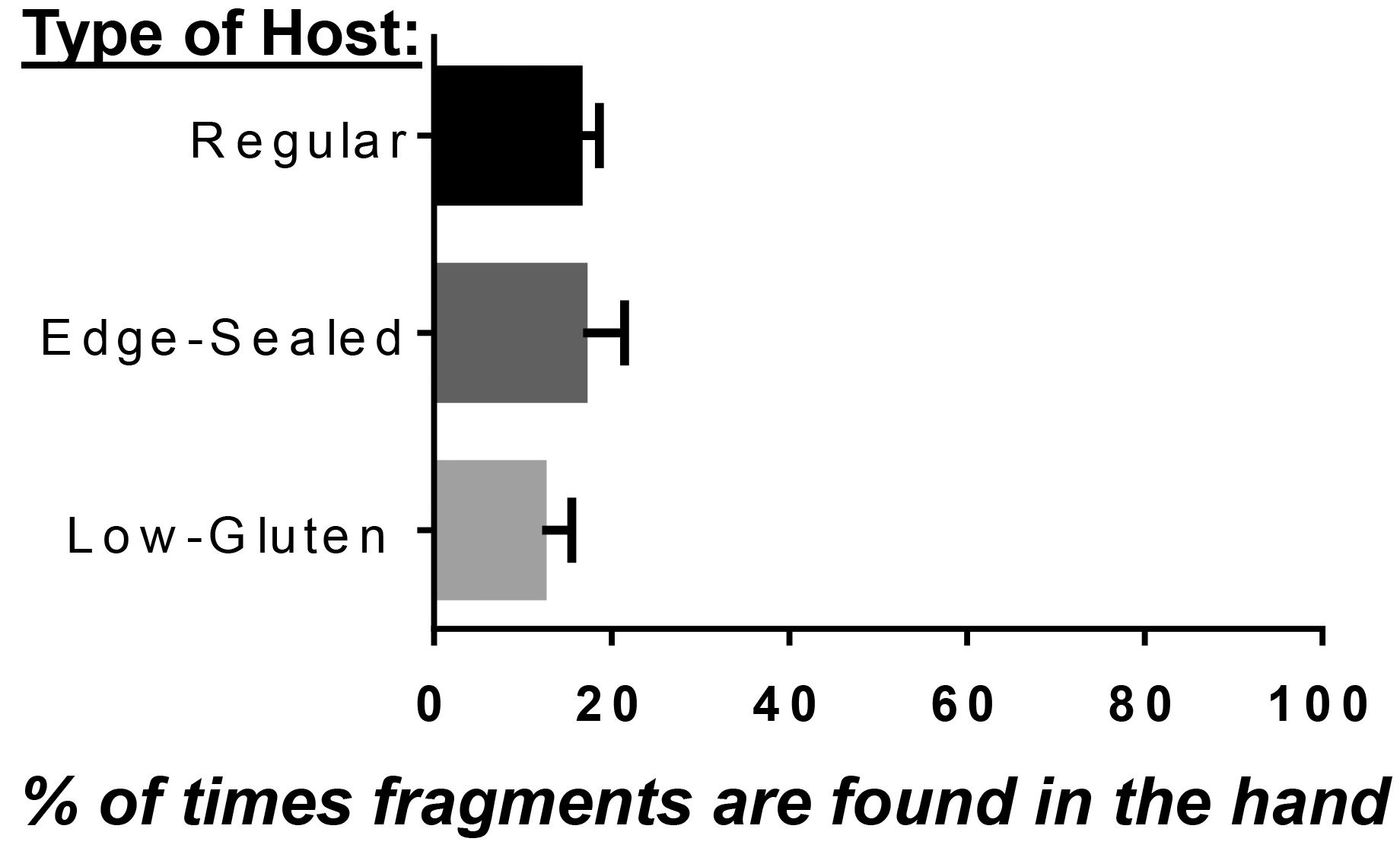By Antoine and Maria Ménoret
Many things have been printed on the history and debate over distributing the Eucharist in the hand or on the tongue.[1] One topic we have never seen discussed is why Catholic priests do not mandate communicants to check for Eucharistic fragments when they receive in the hand. This negligence has led to the dropping of these fragments, and ultimately forces every person who walks in any cathedral, church, shrine or chapel, where communion is distributed in the hand, to crush our conscious and living Lord under their feet.
Inspired by both scripture and tradition, the Catholic Church teaches:
The Eucharistic presence of Christ begins at the moment of the consecration and endures as long as the Eucharistic species subsist. Christ is present whole and entire in each of the species and whole and entire in each of their parts, in such a way that the breaking of the bread does not divide Christ (CCC 1377).
Consequently, Catholics believe Jesus is mysteriously present, whole and entire (body, blood, soul, and divinity), not only in the whole Host but also in a small particle of the Host and in a single drop of His Precious Blood.

Fragments of the Host are visible even before the consecration (Fig. 1). Hence, the Catholic priest is taught to be particularly careful with the small pieces of consecrated Hosts. Consequently, the corporal, a piece of cloth placed on the altar, collects fragments which inevitably occur at the breaking of the consecrated host. Similarly, the paten, a metal plate placed under the hands or the chin of the faithful, collects Eucharistic fragments which may fall during distribution of Holy Communion. The General Instruction of the Roman Missal (GIRM), the document governing the celebration of the Novus Ordo Mass, paragraph no. 278, commands the priest that:
Whenever a fragment of the host adheres to his fingers, especially after the fraction or the Communion of the faithful, the priest is to wipe his fingers over the paten or, if necessary, wash them. Likewise, he should also gather any fragments that may have fallen outside the paten.
After communion, GIRM no. 162 commands that:
Upon returning to the altar, the priest collects any fragments that may remain. Then, standing at the altar or at the credence table, he purifies the paten or ciborium over the chalice, then purifies the chalice.
The priest purifies the ciborium and the chalice because if any fragment or drop remains on the vessels, that is God, and God can’t be relegated to any mundane storage place.
Sadly, a double standard takes place during Mass. The great care that the priest is obligated to perform at the altar to prevent the loss of particles is not replicated by the faithful who receive in the hand. For example, Extraordinary Eucharistic Ministers (lay parishioners trained to distribute the Eucharist) are instructed to wash their fingers with water in an ablution bowl after distribution of the Eucharist. However, lay communicants touching the Eucharist with their fingers never have this opportunity. The faithful then ignore Eucharistic fragments, lose them, and even those who receive on the tongue end up walking on fragments left behind by others.
Reception of the Eucharist in the hand was permitted only with repeated warnings. Pope Paul VI, deeply aware of the potential sacrilegious danger of receiving communion in the hand, recalls the great caution against that practice since the 3rd century:
In fact, the faithful regarded themselves as guilty, and rightly so as Origen recalls, if, after they had received the body of the Lord and kept it with all reverence and caution, some part of it were to fall to the ground through negligence.[2]
In his instruction Memoriale Domini of 29 May, 1969, fully aware of the frequent occurrence of particles of the Eucharist, Pope Paul VI re-affirmed the maintenance of the traditional practice in use (communion on the tongue) and reiterated his caution about distributing in the hand. Paragraph #5 states “Whatever procedure is adopted; care must be taken not to allow particles of the eucharistic bread to fall or be scattered.” However, permission for administering Communion in the hand was granted by the Holy See, first to Belgium on the 31st of May 1969, then to the rest of the world, country by country, during the next decade.
This permission did not include a requirement of the faithful to venerate and care for the particles. As a result, it is indisputable that the modern practice of Communion in the hand is not, as was claimed, a reviving of the ancient Church custom (with its numerous customs of venerating the particles) but rather an introduction into the Church of the heretical Communion in the hand (something entirely different, not venerating particles) first practiced by Protestants.
In 1973, after a few years of experience in the practice of receiving in the hand, the Congregation for Divine Worship and Sacraments stated again:
Especially in the manner of receiving Holy Communion (in the hand) some points indicated from experience should be most carefully observed. Let the greatest diligence and care be taken particularly with regard to fragments, which perhaps break off the hosts. This applies to the minister and to the recipient whenever the Sacred Host is placed in the hands of the communicant.[3]
Clearly, the Catholic Church has been fully aware and concerned, for some time, that fragments of the Eucharist are inevitably produced at every Mass and could easily be desecrated.
Reception in the hand has led to a vicious and wide spread desecration of the Eucharist. In many places, receiving Holy Communion has become a routine act, a mere custom, and often an illustration that many do not believe in the real presence of Jesus in the Eucharist. Aggravating this fundamental lack of belief, three “technical” reasons have exponentially made people unaware of the presence of fragments of the Host.
The first reason is that fragments are most often the same color as the palm of the hand and fingers, hence mostly unnoticed. Searching very carefully for the presence of fragments (using un-consecrated commercially available hosts) we observed the presence of fragments not only in the hand but also very often on the fingers used to bring the host to the mouth (see Fig. 2).[4]

The second reason relates to the relatively low frequency one detects a fragment in the hand. Based on testing, fragments were found on the hand about 15-20% of the time irrespectively of the type of host used (Fig. 2). Interestingly, our test with edge-sealed hosts, designed to decrease the production of fragments, didn’t show a lower percentage of fragments in the hand. Based on these measurements, a weekly communicant may receive a fragment only about once every two months, perhaps never noticing it. More importantly however, if fragments are present at an even more conservative rate, let’s say only one tenth of the time, it stands to reason that at each Mass about 10% of the parishioners receive fragments with the host. At a Mass with 300 people, about 30 of them will receive fragments of Christ and scatter Him all over the building.
Finally, the third reason is a chronic lack of teaching on the subject. The overwhelming majority of the clergy are either oblivious or neglectful of this problem, and do not educate the faithful on how to avoid desecration of the Eucharistic fragments.
All over the world, at every Sunday and weekday Mass, for five decades (except in parishes where communion is distributed exclusively on the tongue), while the priest takes great care in protecting the Eucharist and its fragments at the altar, the faithful unknowingly scatter the small and numerous Eucharistic fragments that stick to the fingers and are easily dispersible. Even if most parishioners receive on the tongue, a minority of reception in the hand suffices to guarantee desecration because anyone can trample on the lost Eucharistic fragments. It is unthinkable to consider that just a few occurrences of trampling on Jesus Christ are acceptable. Objective evil is repetitively accomplished right in front of our eyes during Mass, the most holy prayer of the Catholic Church.
What Then Must We Do?
The sixth chapter of the Gospel of John starts with the feeding of the five thousand. Pieces of bread were left over from the multiplied loaves. Perhaps in preparation for our times, Jesus commands His disciples to Gather up the fragments that remain, lest they be lost (John 6:12). Later, Jesus reiterates the importance of the fragments when he asked His disciples, twice, how many baskets of fragments were collected (Mark 8:19-20). Knowing how this chapter of the Gospel of John is famous for instructing Jesus’ disciples that the Eucharist is truly his own Flesh and Blood, a parallel can easily be drawn with our current situation where Eucharistic fragments are not “gathered up.”
Desecration of Eucharistic fragments can be easily eliminated when Catholic clergy and laity are willing to truly follow Jesus’ command to gather the fragments that remain. Priests and catechists ought simply to mandate the faithful to immediately and carefully inspect their hands upon receiving communion and consume all the fragments they find. This recommendation is sound, in harmony with the teaching of the Church and her repeated caution about distribution in the hand. This simple practice would considerably diminish desecration. Importantly, even if laity exercise their right to receive on the tongue; a right which has been confirmed by the Holy See multiple times, fragments will still be scattered by those who receive in the hand. Therefore, solely distributing on the tongue at every Mass, as practiced in the traditional Latin Mass and certain Novus Ordo churches, is the only way to guarantee the absence of Communion on the floor and involuntary desecration.
In many parishes, the steps taken to guard against the slightest contact with a virus, which we cannot see, has gone beyond scrupulous. There is no excuse for not being equally scrupulous to protect our Lord, Whom we can plainly see in the fragments of the Eucharistic Host. Catholics should spare nothing to protect the Lord from the slightest possibility of being lost and trampled upon. As one bishop responded to us about the fragment problem:
If you are aware of the fact that on the floor fragments of the consecrated hosts are scattered in churches where Communion in hand is given, then it would be for you justified not to go to Holy Communion in those churches where Communion in hand is distributed (Bishop Athanasius Schneider).
[1] Editor’s note: the indispensable text on this topic is the work of Bishop Juan Rodolfo Laise, which is now in its fifth English edition from PCP Books.
[2] Paul VI, Mysterium Fidei (1965), 58.
[3] Immensae Caritatis, January 25, 1973.
[4] Description of our experiment: commercially available unconsecrated hosts, regular (cat# YS436), edge-sealed (cat# 61651CNT), and low-gluten (cat# J0528) were purchased from Autom.com and tested for release of fragments upon distribution in the hand. One host at a time was placed in the hand of the recipient who grabbed it with its finger and consumed it. Then the recipient inspected his fingers and the palm of his hand very thoroughly, by the naked eye under strong illumination, for the presence of visible fragment(s). The procedure was repeated 20 to 30 times for one trial, and the presence of fragments detected on the hand was reported as percentage of times fragments are found in the hand for that trial. Four independent trials were performed for each type of host with 2 different recipients. The bars represent the average of 4 trials +/- standard error of the mean; t-test analysis showed no statistical difference between the groups.


